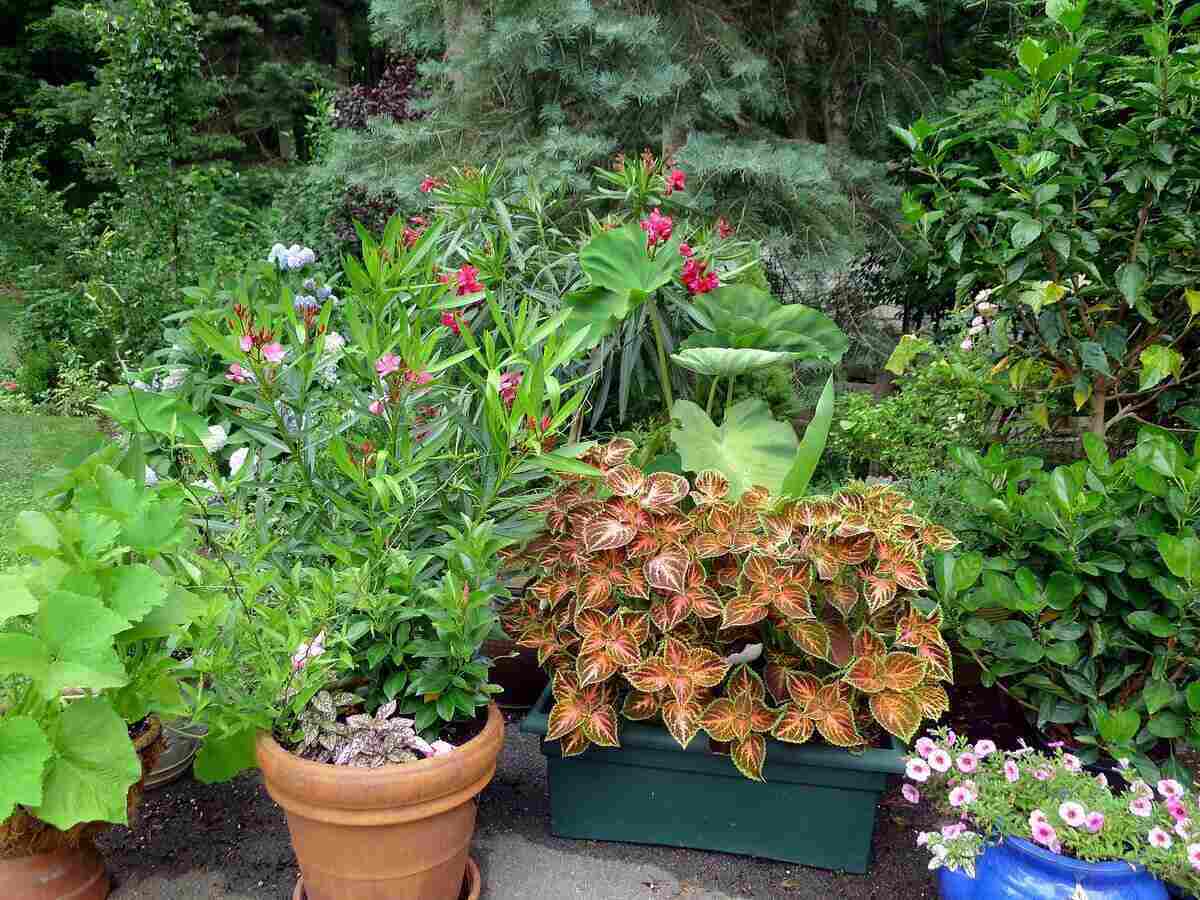
Container gardening solves the problem of no garden space or limited full sun in your landscape. It’s also the answer for apartment and condo dwellers who want to grow herbs, flowers or veggies on their balconies or patios.
In this guide to container gardening, we’ll cover what you will need, some of the best vegetables and fruits to grow in containers, and how to care for plants growing in containers on your patio or outside your window.
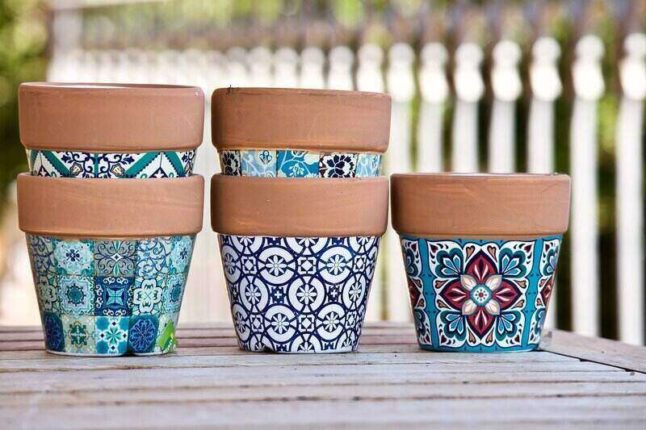
So why are container gardens a big deal? Container gardens are perfect for small spaces, where pots can be fit rim to rim to create a garden scene. The only downsides? Containers break and plant roots outgrow pots.
Another benefit of container gardens? Container gardens also can serve as moveable feasts for the eyes or throw pillows for your yard adding a spot of color here or there. The pots can be there just for the growing season, or provide a place to garden year-round.
Bottom line: Container gardening is limited only by imagination and drainage. From vegetable gardening to growing perennials, annuals and herbs, container gardens are made for the DIYer.
Let’s start this guide with what kind of containers you should use…
What Kind of Garden Containers Should You Use?
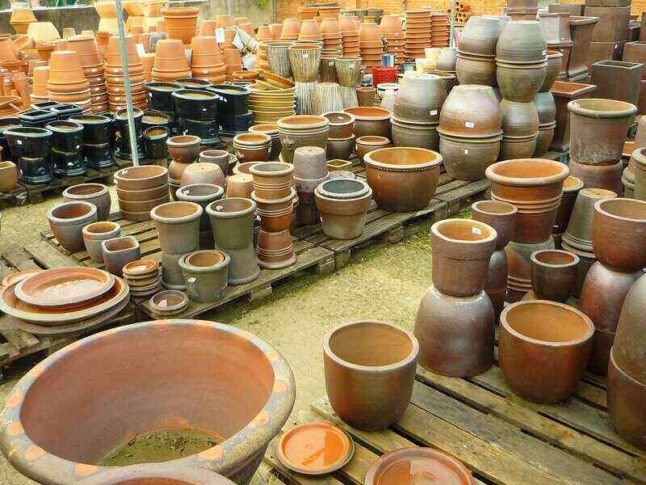
If it holds soil and has drainage, it can be a container garden.
The right containers can stay outside year-round to provide the opportunity to change them with the season, including winter. Southern gardeners want pots that withstand the intense sun without fading or cracking.
Beyond that, think practical in your container choices and look for pots that fit your personality and decor.
Practical
Proper drainage is probably the most important thing to look for in a container for your garden. Many containers come with drainage holes. Sometimes these need to be punched out.
Pro Tip: Adding rocks to the bottom of containers to help with drainage is no longer recommended.
Which containers are best for your garden? Select containers that complement the style of your home, such as contemporary, Colonial or Arts and Crafts.
Quirky
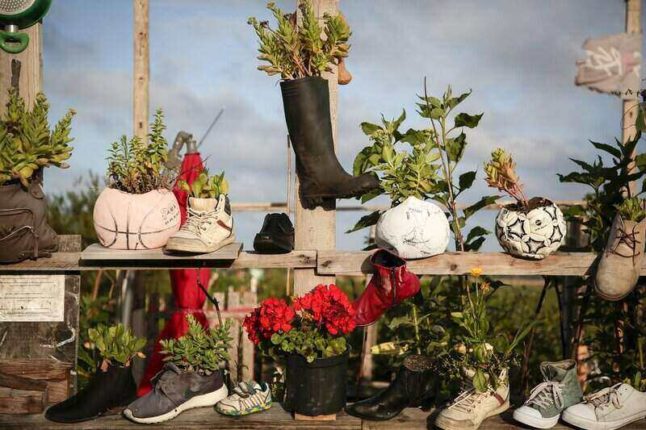
Let your quirky personality shine and plant an old pair of shoes and purse with succulents. Livestock troughs of all sizes have made their way into urban areas, where landscapes may be root bound or have contaminated soil.
Thrifty
Visit Goodwill or other thrift stores and pick up some baskets to plant. Baskets are a fun way to make a seasonal container garden at little cost. Line the basket with a paper towel or cloth to keep the soil from running out, add potting mix, and plant.
Container Garden Considerations
With container gardens, the weight, size and materials of your pots are all considerations.
All of these factors are important if you plan to move your plants around but also worth thinking about if your container garden is on your balcony.
Weight
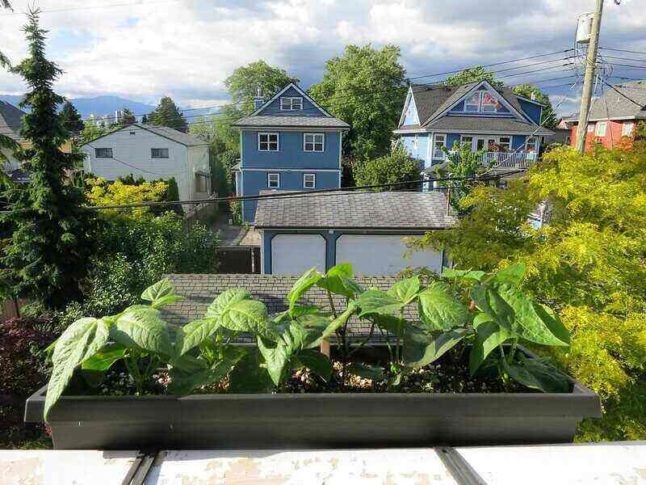
The weight of the pot includes the soil and plants. Check the weight limit for your balcony before starting your gardening in containers there.
Most big box retailer and garden centers have affordable fiberglass or plastic pots. These generally are lighter weight and a good choice for year-round use.
Size
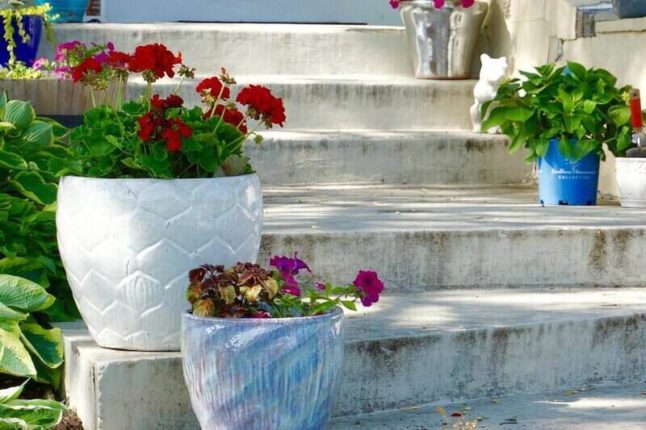
The bigger the container, the harder it will be to move to follow the sun through the year or inside when the cold approaches.
And plants outgrow containers.
For example, trees and shrubs do well in large containers, such as the concrete or ceramic types. Containers in the 2 to 3 foot tall and wide range work well.
Trees and shrubs usually survive about five years, with roots eventually outgrowing the container. Still, a tree or shrub is not a bad choice. If it’s a $100 plant, that’s about $20 a year for your use and enjoyment.
Materials
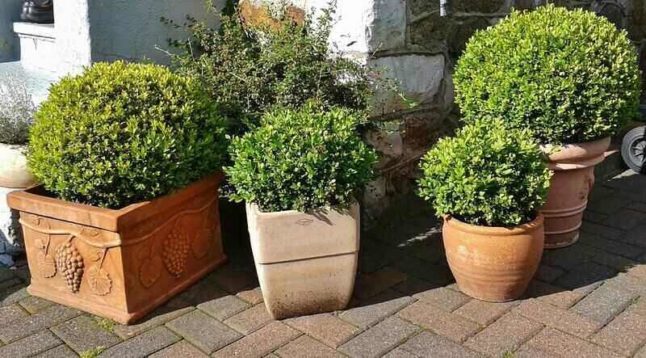
Some materials are better than others for container gardens, especially when it comes to weight and durability. For example, terra cotta pots often aren’t all they’re cracked up to be — pun intended — for container gardens.
What do we mean by this? As much as gardeners love the look of terra cotta pots, the freezing and thawing of the potting soil causes them to crack and crumble.
How to remedy this fragile state? Appreciate your terra cotta pots in spring and summer, but protect them in winter by stowing them (soil and all or empty) in an area protected from freezing.
Container gardens and their materials
Other factors to consider with containers and their materials:
- Window boxes are usually plastic or wood. These can be affixed to a windowsill or zip-tied to a balcony railing. Some gardeners use plastic inserts to extend the life of wood window boxes.
- Ceramic pots are heavy on their own. Add soil and plants that are well watered, and they weigh even more. These weather-resistant pots for container gardening are good for permanent locations or where they are rarely moved. Make sure the ceramic is marked frost tolerant or something similar.
- Concrete containers are heavy, but most also are weather resistant, making them ideal for year-round container gardening. Consider them permanent or rarely moved in the landscape. Crescent Garden’s self-watering containers or Campania International offer lovely designs and forms.
- Metal pots get hot and can burn a plant’s roots.
- Go green and lightweight: The lightest weight pots for gardening in containers are made of cloth spun from recycled plastic bottles. One brand, Smart Pots come in all shapes and sizes to accommodate about any container gardening need. (They even adorned the grounds of the Parliament Building in Quebec City a few years ago.)
- Cloth pots are good for those with limited storage space, too, because after you dump the soil, they fold flat. They also work well on balconies, where there may be weight limits.
Gardening Pro Tip: If you have a fancy urn or other container that doesn’t have drainage, consider double potting. Place a nursery pot or other container inside the fancy urn. Invert nursery pots to raise the planted container to the correct height.
Container Garden Potting Soil (and Other Needed Items)
Once you’ve settled on the pots for your container garden, you’ll need potting soil, a watering can or garden hose, a few other hand tools — and plants, of course.
Potting mix
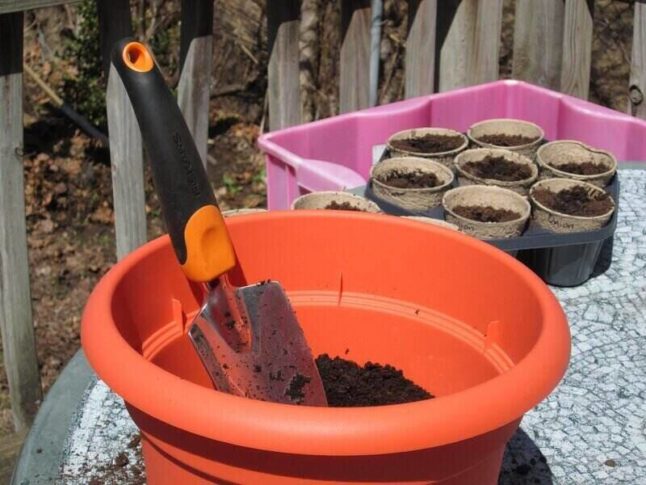
Use a high quality potting mix, frequently labeled for container gardening. These bagged potting mixes are specially formulated to be lightweight and promote good drainage.
There are many soil mix brands available, including organic, and those blended with fertilizers or have an additive to promote moisture control.
Don’t use topsoil because it is heavy and drainage is poor. It may be tempting to dig soil from the landscape, but don’t do it. Garden soil may contain insects or diseases, which you don’t want in your containers.
When to change your potting soil? Some gardeners remove all of the potting mix from their container gardens and replace it every year. Others only change potting soil if the plants in the pot were diseased or infested with insects.
If you are changing potting soil because your plants are diseased or infested with insects, clean the container with a 10% bleach solution. If plants were healthy with no problems, remove and replace the top third of the potting mix.
Bottom line: Every few years, it’s good to dump and replace all of the potting mix.
Items needed for your container garden
- A watering can, pitcher, or garden hose: You’ll need to water your container garden (see How to Care for Your Container Garden for details).
- Garden gloves: Gardening involves getting your hands dirty, but garden gloves keep your hands too dirty. And if you are growing blackberries or roses in containers, garden gloves will protect your hands from thorns.
- A trowel or garden knife (aka hori-hori knife): When you are turning your soil in containers, a trowel or garden knife makes this super easy. Garden knives also can help you in removing weeds and leaves from your containers and a trowel helps in leveling potting soil when you place that in containers.
| ITEMS NEEDED | COST *average cost per item |
| Containers | $10 to $100 or more each (depending on size and material) |
| Potting mix | $16 for a 2-cubic-foot bag |
| Fertilizer | $4 – $9 |
| Watering can or hose | $5 – $25 |
Plants Perfect for Your Container Garden
Just about any kind of plant — vegetable, fruit, flower, or herb — can be grown in containers.
Annuals are the most common plants because they are easy to change from season to season. Annuals can go in about any size container. Think pansies to petunias to mums to holiday greenery.
Perennials — which come back every year — frequently get planted along with annuals and other seasonal plants in ornamental container gardening.
The perennial advantage: Perennials used in container gardens can be planted in the ground in fall and transplanted back to the pots next year.
A popular perennial is coral bell (Heuchera), a North America native plant that comes in several leaf colors and shapes. In many climates, it is evergreen, making it a good selection for use year-round.
5 perennials for your container garden
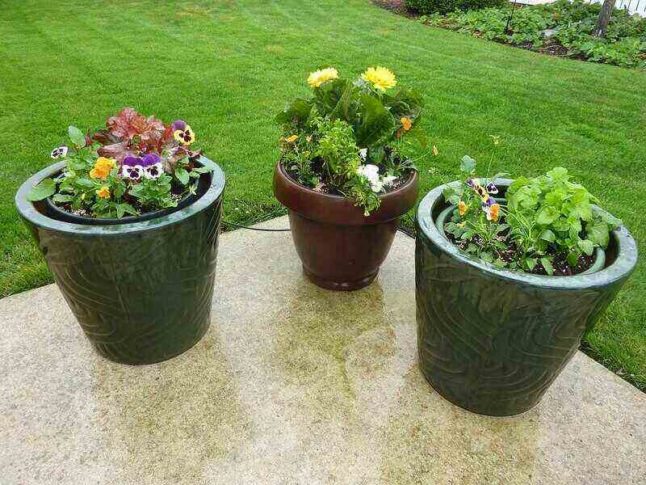
Consider mixing these perennials with seasonal plants, such as spring bulbs or summer and fall mixes.
- Coral bell (Heuchera)
- Hosta
- Lamium
- Pincushion flower (Scabiosa)
- Sedum
Vegetables for container gardens
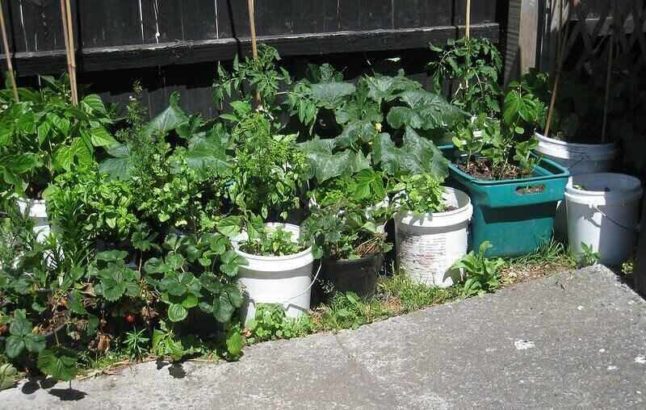
From lettuce to tomatoes, vegetables are easy to grow in pots — and plant breeders are making this easier through genetics.
Plant breeders have developed plants specifically for container gardens. These are smaller plants but with high yields. At garden centers or online retailers, look for plants labeled for container planting.
Traditional vegetable plants also can be grown in containers. Larger containers, a 5-gallon bucket size, for example, are best for tomatoes, peppers and eggplants.
Bush-type plants rather than climbers are best for container gardens. Beans, peas, cucumbers and zucchini all come as bush types.
Some vegetables ideal for container gardens (minimum size container for most vegetable plants is 15 inches tall and 12 inches wide):
- Broccoli, one per container.
- Bush beans, peas, cucumber and squash, one per container.
- Cabbage or cauliflower, one per container.
- Eggplant, one per container.
- Lettuce, mesclun, kale, chard, spinach and other greens: These can be mixed in containers or planted separately.
- Tomato, one per container.
- Pepper, one per container.
- Potatoes, 5 seed potatoes per container.
- Onion, garlic and scallions, 5 bulbs per 10-inch tall and wide container.
Fruits to grow in your container garden
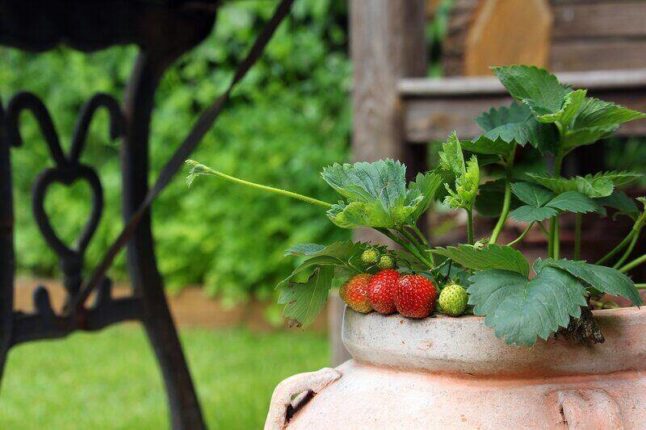
Many fruit plants also have been downsized for containers, including raspberries and blueberries.
Columnar apple trees, which only get about 2 feet wide, work well, too.
At garden centers, look for dwarf fruit plants or those labeled good for containers. Even though dwarf plants, containers should be in the 12- to 18-inch tall and wide range.
Herbs for your container garden
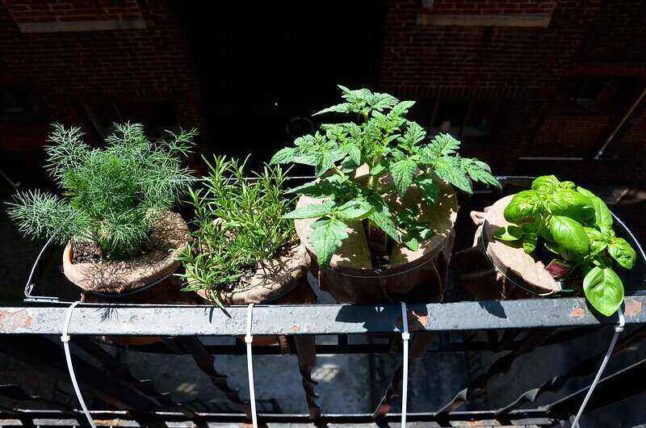
If you like fresh basil to go on your pizza or cilantro for your tacos or bahn mi sandwiches, you can grow your own in your container garden.
>10 herbs to grow in container gardens (most will do well in 6- to 10-inch tall and wide containers):
- Basil
- Chives
- Cilantro
- Dill
- Fennel
- Oregano
- Parsley
- Rosemary
- Thyme
- Mints
Caring for Your Container Garden
Watering container gardens
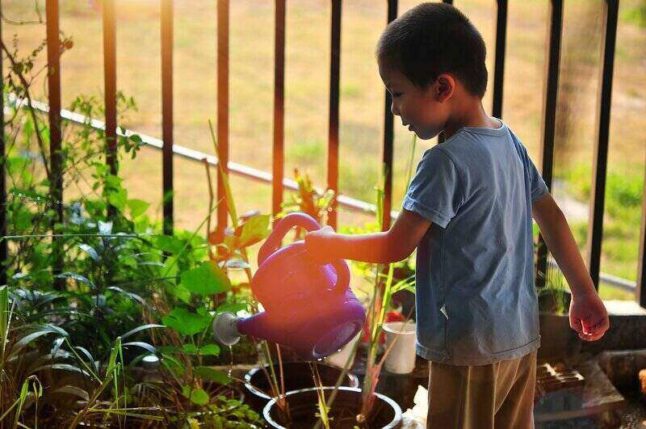
Just add water. Once you have your containers, potting soil, and plants, all you need to do is add water. But here’s what you need to know to keep your container garden vegetables, fruits, flowers and herbs thriving with regular watering:
Use your finger as a dipstick: Gardening in containers usually requires a bit more attention than in-ground gardening. Monitor water needs with your index finger. If the potting mix feels dry to the second knuckle, water.
How to water the right amount: Always water the container until water runs out the bottom. Avoid letting pots sit in saucers of water for more than a few hours. If the water runs through the pot immediately, the potting mix may be hydrophobic, or unable to soak up water.
Water from the bottom up: Place the pot in a bucket or tub of water to allow the potting mix to take up the water from bottom to top. Or give the pot a s-l-o-w trickle of water from the top.
Ice makes watering easy: Toss a few ice cubes in your container garden, but make sure the cubes are not touching the plants. As the cubes melt, the ice slowly moistens the top, making it easier to take up water when you water.
Water plants in terra cotta pots more often: Terra cotta pots dry out quickly.
Weeding your container garden
Weeding is easier in container gardens. Since you are using potting soil in containers, you don’t have weeds and their seeds already in the ground ready to spring up, as you do in a flower bed in your yard.
Birds and the wind can drop seeds in your containers, but in general, your weeding chores are far less with container gardens. And because your plants are in pots, you are stooping a little less to remove weeds, too. This saves your back and knees.
Fertilizing your container garden
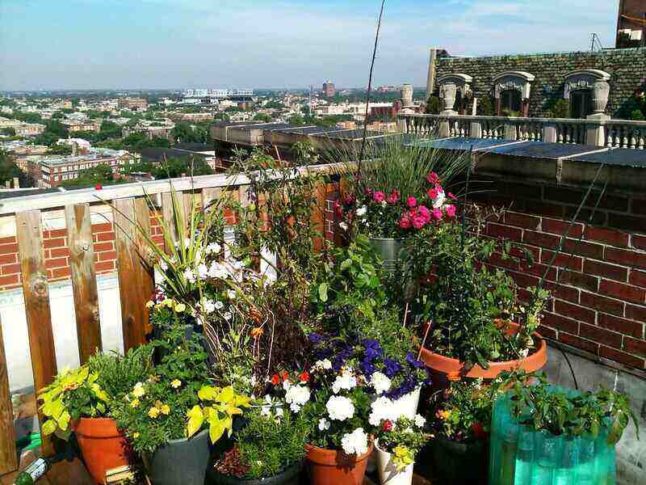
Remember how we said just add water to your container garden plants? Well, you can add fertilizer when needed, too, and here’s how to apply the right amount.
Fertilizer usually comes in two forms: Liquid or granular.
Granular fertilizer is good to use when planting the container garden. It is mixed with the potting mix or added to the surface after planting. Water it in well.
Liquid fertilizer is applied in place of a watering, if the potting mix is not bone dry. If the mix is dry, water first, then fertilize.
Other notes about fertilizers for container gardening:
- There are organic fertilizers, such as fish emulsion, and liquid ready-to-use types.
- Fertilizers may be formulated for particular plants, such as roses, vegetables, annuals, trees, evergreens, perennials, bulbs or houseplants.
- Houseplants, technically known as tropical plants, frequently spend summers outdoors in northern climates and would be considered another type of container gardening.
- Osomote is a well-known brand of slow-release fertilizer. Use at planting. Depending on rain and supplemental watering, an application of liquid fertilizer may be necessary to keep plants their showiest best.
- Always read and follow the fertilizer’s label directions for container plants. Too much fertilizer in container gardens can be bad for the plants.
Container Gardening is Gardening Made Easy
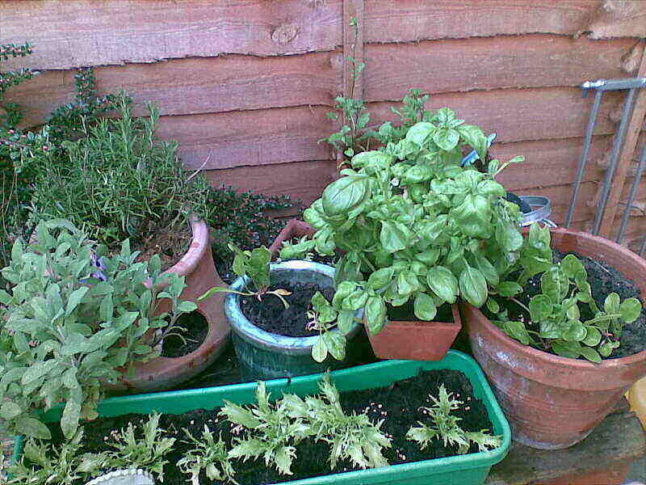
Worried you don’t have a green thumb? Don’t. With a container garden, just pick your pots (or a pair of old cowboy boots as a container), add potting mix, your preferred plant, and water as needed. Put your plant in the sun (if it thrives in full sun) and you’re good to go.
For gardeners, planting container gardens is the best part. Indulge your creativity with design and curiosity by trying new plants.
Less work
With container gardens, there’s less to tend to, too. Add water and fertilizer as needed, and there will be fewer weeds to pull, too. Rabbits and other pests are less likely to nosh on your greenery too, since your fruits and veggies are at a height above ground level.
Move your container garden indoors in winter
Come wintertime, you can move your container garden inside — just remember to plan for this so you don’t pick containers that are too heavy to lift or slide.
Moving your herb garden indoors for winter has obvious and savory benefits. You’ll have chives for dips and other herbs for your favorite recipes. You’ll also have peppermint or spearmint to help your house smell fresh.
How to Get Started Container Gardening
Ready to get started on your container garden? Use this guide to pick out your containers, round up the few needed tools, select some of your favorite fruits, vegetables, trees, shrubs, and herbs, and then care for your container garden.Need more help? Consider calling a local landscape professional near you.
Main Photo Credit: Lori L. Stalteri | Flickr | CC BY 2.0